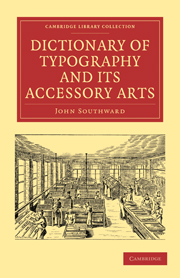Summary
PACK.—Fifty-two cards made into a bundle.
PAGE.—One side of a leaf of a book, derived from the Latin pagina, the thing fastened, because originally leaves were fastened together, and the modern system of imposing the matter of leaves together was not invented.
PAGE CORD.—A description of strong thin twine used by printers for tying up pages of matter.
PAGE GAUGE.—A gauge used by compositors for measuring the length of pages during the operation of making-up. When a new work has been commenced, the compositor who has set the first take of copy marks off a certain number of lines according to the size of the page, adding the folio and white lines; he then places a piece of reglet down the side of the page, close up to the head of the galley, and cuts a notch where the page terminates.
PAGE (TYING UP A).—This is a very simple operation, but one that requires a certain amount of knowledge and experience to perform it properly. The proper way to tie up a page for imposing is to begin at the left top corner of the page as it lies on the galley, wrap the cord round from left to right, and tighten each successive round at the right top corner. Passing it round about three times, and taking care to make the first end additionally secure each turn, draw the cord tight through that which is wrapped on the page so as to form a noose, the end of which is left two or three inches out for the convenience of untying when imposed.
- Type
- Chapter
- Information
- Dictionary of Typography and its Accessory Arts , pp. 98 - 116Publisher: Cambridge University PressPrint publication year: 2010First published in: 1875



